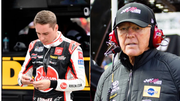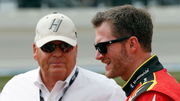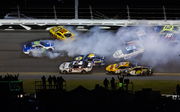
USA Today via Reuters
Jul 2, 2023; Chicago, Illinois, USA; NASCAR Cup Series driver Shane Van Gisbergen (91) reacts after winning the Grant Park 220 of the Chicago Street Race at Chicago Street Race. Mandatory Credit: Mike Dinovo-USA TODAY Sports TPX IMAGES OF THE DAY

USA Today via Reuters
Jul 2, 2023; Chicago, Illinois, USA; NASCAR Cup Series driver Shane Van Gisbergen (91) reacts after winning the Grant Park 220 of the Chicago Street Race at Chicago Street Race. Mandatory Credit: Mike Dinovo-USA TODAY Sports TPX IMAGES OF THE DAY
The NASCAR world has embraced a new star in Shane van Gisbergen, the victor of the Chicago street race. Hailing from New Zealand, SVG is a versatile talent, excelling as a supercar driver back in Australia. Returning to Trackhouse Racing, he’s set to compete in their Project 91 car at the Indianapolis road course. This marks his second NASCAR stint, yet he has already earned a devoted fan base.
Treating fans to behind-the-scenes glimpses of his journey to the NASCAR realm, Trackhouse Racing team owner Justin Marks and van Gisbergen took a stroll around Indy’s Gasoline Alley with RACER’s Marshall Pruett, where Justin underscored the certainty of SVG’s impactful arrival.
ADVERTISEMENT
Article continues below this ad
NASCAR’s new direction paves the way for SVG in the sport
During the conversation, Marks delved into their shared passion for sports car racing and the crossover between their driving backgrounds. With his extensive experience in road racing, Marks expressed his fondness for the endurance factor that dominates sports car racing, including talented drivers like Marcus Ambrose and Scotty McLaughlin, and his personal attachment to that realm.
“I love the endurance aspect of sports car racing, so it’s definitely like a personal little passion project or kind of to be able to bring a guy like Shane from Supercars, which I’ve always been a fan of. I think it’s always been some of the greatest racing in the world.”
Marks emphasized his strategic move to bring SVG as he believed the new direction of the sport, particularly its shift toward street courses and road racing, presented a unique opportunity to showcase SVG’s skills. Reflecting on SVG’s remarkable victory in the Chicago street race, Marks revealed,
Read More: Dale Earnhardt Jr Believes Shane Van Gisbergen?s NASCAR Destination Is All Set
“We were going to street courses. It’s a much more road racing-type car. But now the opportunity existed to bring someone like that in to do something really incredible that the sport has never seen before, and obviously, we did that in Chicago.”
Trending
Shane van Gisbergen’s insights on Next-Gen vs. Supercar dynamics
In a similar conversation with Dale Earnhardt Jr. during his podcast, van Gisbergen discussed the similarities and differences between NASCAR’s Next-Gen cars and Supercars. Addressing the comparison, he noted,
“They?re they are in some parts with the way the chassis is. So you know, it?s the same for everyone. All the components are the same. And the front, rear clips, Yeah, they?re pretty similar in some ways, but the weight of the car is. It?s 300 kilos [661 lbs], I think.”
ADVERTISEMENT
Article continues below this ad

via Imago
NASCAR, Motorsport, USA Cup Practice & Qualifying Aug 12, 2023 Speedway, Indiana, USA NASCAR Cup Series driver Shane Van Gisbergen 91 during practice for the Verizon 200 at the Brickyard at Indianapolis Motor Speedway Road Course. Speedway Indianapolis Motor Speedway Road Course Indiana USA, EDITORIAL USE ONLY PUBLICATIONxINxGERxSUIxAUTxONLY Copyright: xMikexDinovox 20230812_mcd_ad4_24
Diving into distinctions in driving dynamics, SVG highlighted the contrast in downforce distribution and handling characteristics, explaining how the spool differential in Supercars influenced their turning behavior. Despite differences, he acknowledged a general conceptual similarity between the two, underscoring the intriguing crossover between Next Gen and Supercar design.
?But it?s so much heavier, the tires much wider and all the downforce underneath with the underbody and whereas ours is on the top with the big wings. So the way they drive and react is very different, especially because of the spool diff we have. Our cars don?t turn, so you?re constantly trying to get turned in them, whereas these cars, it looks like you?re trying to get a rear grip on exit with all the power. So very different. But yeah, I guess the overall concept is?similar, yeah.?
ADVERTISEMENT
Article continues below this ad
Watch This Story:?Bristol Motor Speedway Owners Rejected Brainchild Could Have Prevented NASCAR 2023 Seasons Biggest Adversity
Amidst the blend of similarities and distinctions, coupled with his debut triumph, SVG appears to be adapting admirably to NASCAR. With doubts over his initial success, Indy stands as SVG’s chance to prove his mettle, dispelling any notions of luck and cementing his prowess on the track.
ADVERTISEMENT
ADVERTISEMENT
ADVERTISEMENT
ADVERTISEMENT






